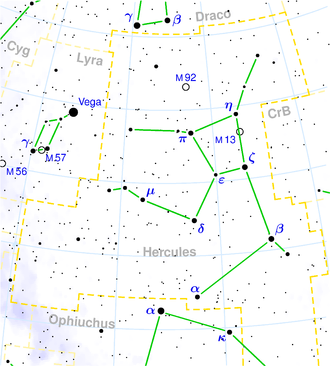Arp 272
| Galaxie Arp 272 | |
|---|---|
| Aufnahme des Hubble-Weltraumteleskops | |
| AladinLite | |
| Sternbild | Herkules |
| Position Äquinoktium: J2000.0, Epoche: J2000.0 | |
| Rektaszension | 16h 05m 23s[1][2] |
| Deklination | +17° 45.4′ [1][2] |
| Erscheinungsbild | |
| Morphologischer Typ | NGC: SA(s)c/AGN IC: SB(rs)cd[3] |
| Helligkeit (visuell) | NGC: 14,1 mag IC: 15,4 mag[3] |
| Helligkeit (B-Band) | NGC: 14,8 mag IC: 16,1 mag[3] |
| Winkelausdehnung | NGC: 0,9'/0,6' IC: 0,4'/0,3'[3] |
| Positionswinkel | NGC: 132° IC: 35°[3] |
| Flächenhelligkeit | NGC: 13,3 mag/arcmin² IC: 12,9 mag/arcmin²[3] |
| Physikalische Daten | |
| Zugehörigkeit | Abell 2151 (Hercules-Cluster) |
| Rotverschiebung | 0,037116 ± 0,000027[1] 0,031928 ± 0,000104[2] |
| Radialgeschwindigkeit | (11127 ± 8) km/s[1] (9572 ± 31)[2] km/s |
| Hubbledistanz vrad / H0 | (502 ± 35) · 106 Lj (153,8 ± 10,8) Mpc [2] |
| Geschichte | |
| Entdeckung | Lewis Swift |
| Entdeckungsdatum | 27. Juni 1886 |
| Katalogbezeichnungen | |
| NGC 6050 • IC 1179 • UGC 10186 • PGC 57053/8 • CGCG 108-118 • MCG +03-41-92/3 • Arp 272 • VV 220 • | |
Arp 272 ist ein interagierendes Galaxienpaar im Sternbild Herkules, welches etwa 475 Millionen Lichtjahre von der Milchstraße entfernt ist. Seine Komponenten tragen die Katalogbezeichnungen NGC 6050 und IC 1179.
Halton Arp gliederte seinen Katalog ungewöhnlicher Galaxien nach rein morphologischen Kriterien in Gruppen. Dieses Galaxienpaar gehört zu der Klasse Doppelgalaxien mit verbundenen Armen.
NGC 6050 wurde am 27. Juni 1886 vom US-amerikanischen Astronomen Lewis A. Swift entdeckt.[4][5][6]
Weblinks
Literatur
- Jeff Kanipe und Dennis Webb: The Arp Atlas of Peculiar Galaxies – A Chronicle and Observer´s Guide, Richmond 2006, ISBN 978-0-943396-76-7
Einzelnachweise
- ↑ a b c NASA/IPAC EXTRAGALACTIC DATABASE NGC 6050
- ↑ a b c d NASA/IPAC EXTRAGALACTIC DATABASE IC 1179
- ↑ a b c d e f SEDS: NGC 6050
- ↑ J. L. E. Dreyer: The New General Catalogue of Nebulæ and Star Clusters. 1888. Seite 166 (Memento vom 12. März 2016 im Internet Archive)
- ↑ Wolfgang Steinicke: Observing and Cataloguing Nebulae and Star Clusters. Cambridge University Press, 2010, Seite 355. (Online-Vorschau auf books.google.de)
- ↑ Seligman: NGC 6050 (= IC 1179 = PGC 57053 + PGC 57058 = Arp 272). In: cseligman.com. Seligman, abgerufen am 15. Oktober 2021.
Auf dieser Seite verwendete Medien
NGC 6050/IC 1179 (Arp 272) is a remarkable collision between two spiral galaxies, NGC 6050 and IC 1179, and is part of the Hercules Galaxy Cluster, located in the constellation of Hercules. The galaxy cluster is part of the Great Wall of clusters and superclusters, the largest known structure in the universe. The two spiral galaxies are linked by their swirling arms. Arp 272 is located some 450 million light-years away from Earth and is the number 272 in Arp's Atlas of Peculiar Galaxies.
This image is part of a large collection of 59 images of merging galaxies taken by the Hubble Space Telescope and released on the occasion of its 18th anniversary on 24th April 2008.
- Left: NGC 6050A
- Right: NGC 6050B
| About the object | |
|---|---|
| Object name | NGC 6050, IC 1179, Arp 272 |
| Object description | Interacting Galaxies |
| Position (J2000) | 16 05 22.97 +17 45 27.2 |
| Constellation | Hercules |
| Distance | 150 million light-years (50 million parsecs) |
| About the data | |
| Data description | The Hubble image was created using HST data from proposal 11095: K. Noll (STScI) |
| Instrument | WFPC2 |
| Exposure date(s) | February 12 - 14, 2007 |
| Exposure time | 5 hours |
| Filters | F435W (B) and F814W (I) |




